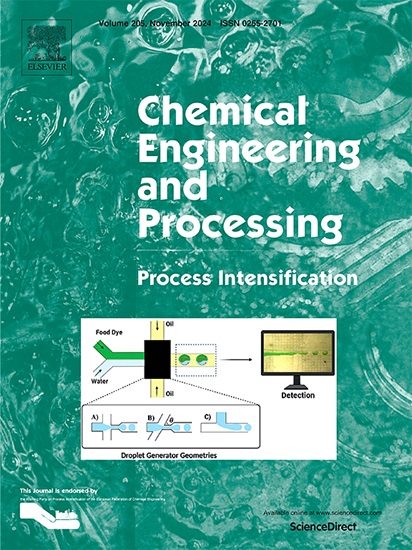Intermittent bed homogenization as a strategy for improving the biodrying process of orange solid waste biomass
IF 3.8
3区 工程技术
Q3 ENERGY & FUELS
Chemical Engineering and Processing - Process Intensification
Pub Date : 2025-06-06
DOI:10.1016/j.cep.2025.110399
引用次数: 0
Abstract
This study investigates the effects of intermittent air flow rate (Q) and bed homogenization period (BHP) on the biodrying process of orange processing waste. A central composite design (CCD) was used to analyze the effect of these parameters on temperature and water removal. The minimum bed temperature (Tmin) during the experiments ranged from 6.8 °C to 17.8 °C, while the mean and maximum temperatures ranged from 11.8 °C to 27.2 °C and 19.9 °C to 44.9 °C, respectively. The final moisture content ranged from 2.59 db to 1.58 db. Besides process achievement of 44.9 °C without external heat, CCD analysis showed that neither Q nor BHP had a significant effect on temperature during the biodrying process. While higher air flow rates improved moisture removal by convective mechanisms, they also increased evaporative cooling, which limited the temperature increase. Bed homogenization increased porosity and prevented preferential pathways but had a negligible effect on water loss and temperature increase. Biomass energy analysis showed that the biomass higher heating value (HHV) was maintained even in experiments where organic matter was consumed to generate heat. This indicates the integrity of the lignocellulosic compounds and preserves the potential of the waste for energy recovery. It was possible to identify challenges in optimizing biodrying processes, especially in systems with native microorganisms, highlighting the importance of detailed characterization of the microbiota. Future research should focus on refining operational parameters to improve water removal and thermal efficiency, thus contributing to sustainable waste management and process intensification.

间歇式床均质作为改进柑桔固体废弃物生物质生物干燥过程的策略
研究了间歇空气流速(Q)和床层均质周期(BHP)对柑桔加工废弃物生物干燥过程的影响。采用中心复合设计(CCD)分析了这些参数对温度和去除率的影响。实验期间床层最低温度(Tmin)为6.8 ~ 17.8℃,平均温度和最高温度分别为11.8 ~ 27.2℃和19.9 ~ 44.9℃。最终含水率为2.59 ~ 1.58 db。除了在没有外界加热的情况下达到44.9°C外,CCD分析表明,Q和BHP对生物干燥过程中的温度都没有显著影响。虽然更高的空气流速通过对流机制改善了水分的去除,但它们也增加了蒸发冷却,这限制了温度的升高。床层均质化增加了孔隙度,阻止了优先通道,但对失水和温度升高的影响可以忽略不计。生物质能源分析表明,即使在消耗有机物产生热量的实验中,生物质的高热值(HHV)仍然保持不变。这表明了木质纤维素化合物的完整性,并保留了废物的能量回收潜力。有可能确定优化生物干燥过程中的挑战,特别是在具有天然微生物的系统中,强调微生物群详细表征的重要性。未来的研究应侧重于改进操作参数,以提高水的去除和热效率,从而有助于可持续的废物管理和过程强化。
本文章由计算机程序翻译,如有差异,请以英文原文为准。
求助全文
约1分钟内获得全文
求助全文
来源期刊
CiteScore
7.80
自引率
9.30%
发文量
408
审稿时长
49 days
期刊介绍:
Chemical Engineering and Processing: Process Intensification is intended for practicing researchers in industry and academia, working in the field of Process Engineering and related to the subject of Process Intensification.Articles published in the Journal demonstrate how novel discoveries, developments and theories in the field of Process Engineering and in particular Process Intensification may be used for analysis and design of innovative equipment and processing methods with substantially improved sustainability, efficiency and environmental performance.

 求助内容:
求助内容: 应助结果提醒方式:
应助结果提醒方式:


